#fresco wool is expensive
Explore tagged Tumblr posts
Text
QUESTION FAKS FRESCO WOOL SUITS: SEASON 3 THE BEAR
Ummm where is Fak suddenly getting money to buy Fresco wool suits which are 500.00 to 1250.00 dollars?

Also he was ironing that expensive suit
Seriously not trying to say he can't do it, but why are they trusting Fak to iron a wool suits?
They cost too much
#fresco wool suits#the bear season 3#season 3 the bear#bill black#neil fak#matty matheson#ricky staff#Richie Jerimovich#ayo edebiri jeremy allen white#ayomy#jayo#Jeremy Allen white#Ayo Edebiri#fresco wool is expensive#bill murray#groundhog day#the bear#carmy berzatto#sydney adamu#carmy x syd#love#sydcarmy#slow burn#romance#relationship#richie jerimovich#philip k dick#philip k. dick#time out of Joint
8 notes
·
View notes
Text
Minoan Heanos
The distinctive open-front dresses worn by Minoan women are probably even more iconic than the multi-layered kilts. Over time, there's dispute whether the garment is one piece or a separate bodice and skirt, but currently the one-piece theory is in ascendance.

The word heanos is derived from the Linear B logogram *146, wehanos. The wes- prefix, which is the squiggle in the middle, indicates a garment. Bernice Jones believes that this logogram represents the garment worn by Minoan men and women.
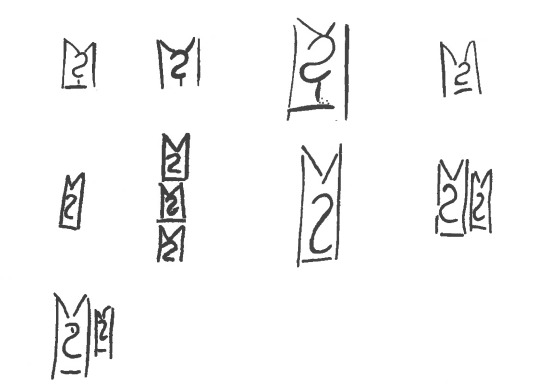
Marie-Louise B. Nosch, The Textile Logograms in the Linear B Tablets, pp 133-138
More research and construction below the cut:
The theory that the garment is a full-length tunic is further supported from imagery from the time, like these figures from the c. 1400 BCE Hagia Triada Sarcophagus. This detail from the sarcophagus shows three figures in some kind of procession, 2 women and 1 man. The woman at left wears a tunic with some kind of pelt as a skirt, and the other 2 figures wear tunics without anything over them, showing that they are one continuous, ankle-length garment.
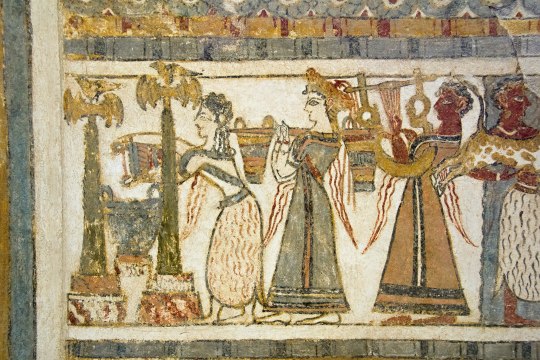
Some of the most important resources for interpreting how the heanos was constructed comes from the two women depicted in the House of the Ladies in Akrotiri, wherein the side seams of the tunic are clearly visible running along the side of the body and under the arm.
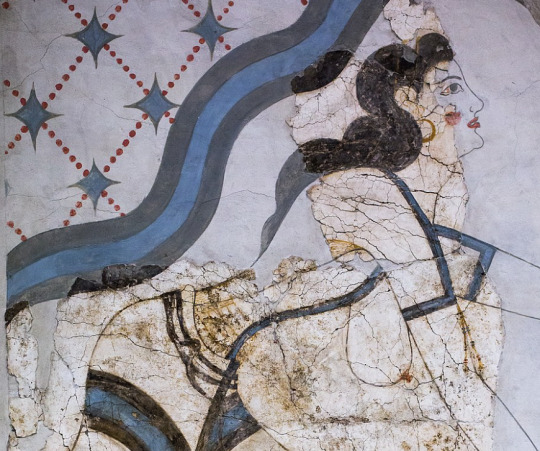
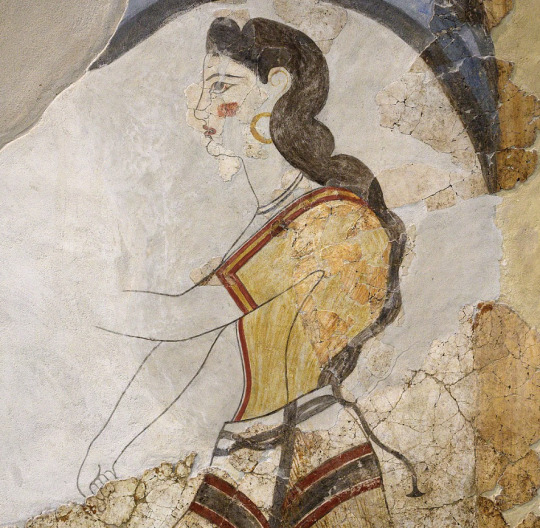
details of figures from the House of the Ladies, Akrotiri, via Wikimedia Commons
advadbsvasb
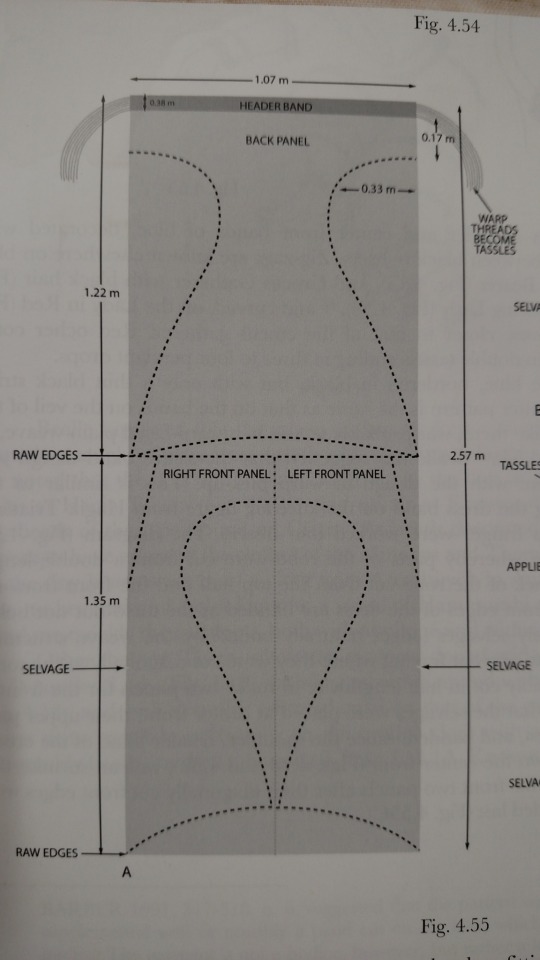

Diagrams from Bernice Jones' book Ariadne's Threads, p. 82, via Gorgeous Tangents
The heanos itself is made of 3 pieces of fabric: 1 back and 2 fronts. These diagrams show a concave hem like on the labrys-shaped kilt but I went with a straight hem, which is an equally valid option. The end of the sleeves are level with the edge of the hem at the widest point. This would probably be the width selvage-to-selvage on the fabric, being narrower than fabric widths commonly are today. There are 4 seams: the shoulder seam, the two side seams, and a front seam (optional, but recommended if you would prefer not being arrested.) It may be tempting to fold the fabric across the shoulder, so the only sewing is side seams and a neck hole, but this makes a weaker garment overall. I used this as a shortcut in my fitting muslin and it caused tears and weak points at the three points of the front opening.

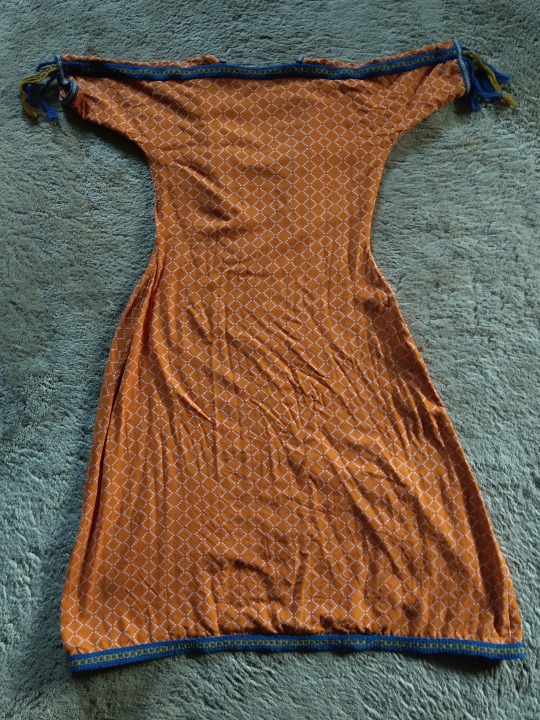
my fabric was a lightweight, moderately loose-woven cotton with a supplementary weave pattern in squares and diamonds. Linen or wool would have been more accurate but also? much harder to find from online quilting stores selling fabric for affordable prices. The main fabric is dark orange and the pattern is made out of pink/lilac threads. This weaving technique resulted in a LOT of long floats (unsecured expenses of thread) on the back--you can see how the wrong side of the fabric is much pinker than the right side. These floats could snag easily if I wasn't careful, so while it made a very effective visual for this tunic, I do not think that this fabric type would be viable for everyday wear. I'll leave it to people who actually know about weaving to ponder what more accurate weaving techniques would be.
Construction
The overall pattern is basically a T-shaped tunic, and the most important measurements are shoulder circumference, shoulder width, bust circumference, and the shoulder-waist length. In addition, you need measurements for the bicep, waist, shoulder-navel length, and hip circumference. After working out the fit with a muslin, I ended up with this pattern, 1 of 4 identical quarters.

Your first impulse may be to make the tunic very close-fitting, since the depictions in frescoes are skin-tight, but since the pattern has no added gusset this is a recipe for Cannot Move Arm. So I gave a very generous curve under the arm, which also made the dress look better when my arms were down, avoiding armpit wrinkles. I continued that ease into about an extra 2 inches added on to my waist measurement and plenty of extra space around my hips so that I could do exciting things like Sit Down.

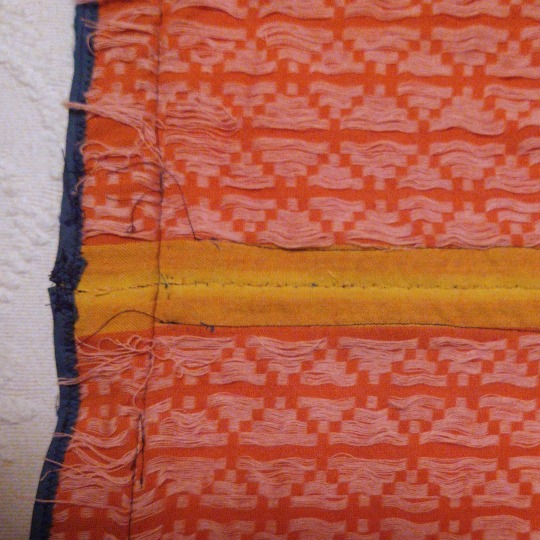
I sewed the shoulder and side seams using the machine, and felled the raw edges on each side of the seam by hand with a whipstitch. I foided back the front edges of the v-neck instead of cutting them, which was a tip I got from the Gorgeous Tangents blog. This strengthens the neckline and keeps it from stretching, and also means that everything can be readjusted if you have size fluctuations or just want to modify the tunic into something more or less modest.
I whipstitched the front edges together by hand--the contrasting selvage didn't matter because it would be covered up by trim. I ended up cutting the tunic a liiiittle shorter than I wanted, so I finished it with some leftover bias binding instead of hemming it to conserve as much length as possible.
Trim

I custom-ordered the woven tape trim from Long Creek Mercantile. Both are made of wool--the "header band" and the hem trim are 1 1/4" wide and the center-front and cuff trim are 3/8" wide. I observed that most images of the Minoan heanos show trim with two colors at most, in a simple geometric or linear pattern, so I consciously restrained myself from ordering anything more elaborate. The clothing on Minoan frescoes is characterized by strongly contrasting colors, so blue trim was the most obvious, and best-looking option. Orange tunics with blue trim appear multiple time in art like the "Dancing Lady" fresco from Knossos:
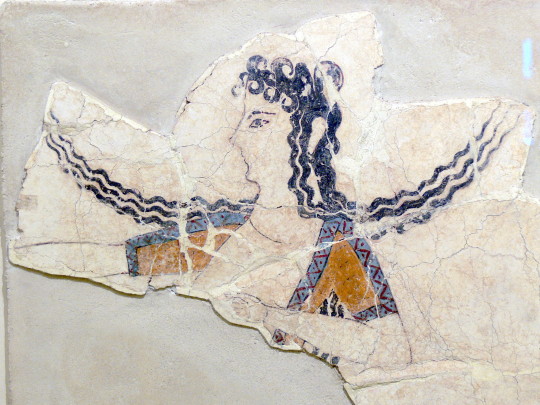
Dr. Jones suggests that the band across the shoulder would historically have been a header band--a band of threads woven at the beginning of a project in order to properly space the warp bands (see her diagram at the beginning). That may be a reason why the shoulder trim often depicted under the front or sleeve trim, as shown above. Regardless, the trim almost always coordinates.
I sewed on the shoulder trim by hand, the sleeve and hem trim by machine, and the center-front trim with a combination of both.
Tassels
Many frescoes from Akrotiri and Hagia Triada show the ends of the supposed header band turned into tassels. This embellishment is not universal among heanoi, as you can see from the "Dancing Lady" above, but it does add a fun little something!
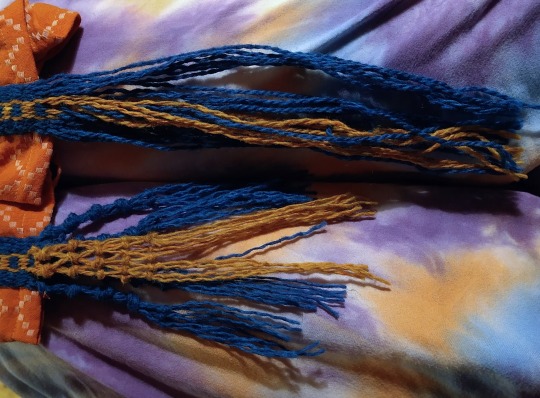
(yes, my Lounging Pants are very fashionable)
I turned the excess ends of the shoulder "header band" trim into fringes, knotting the yellow ones into a lattice and turning the blue yarns into tassels. The lattice-tassel appears on a fresco from Hagia Triada:
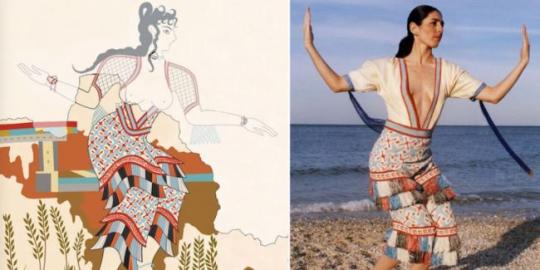
Reproduction of fragmentary fresco from Room 14 at Hagia Triada, Crete
The saffron gatherers from Akrotiri shown below have clearly displayed fringes at the ends of their sleeves. The one on the left has red fringes that appear knotted or ravelled/unravelled in an undulating pattern, and the one on the right has fringes that may be either beaded with papyrus-shaped leaves or cut into short tassels.
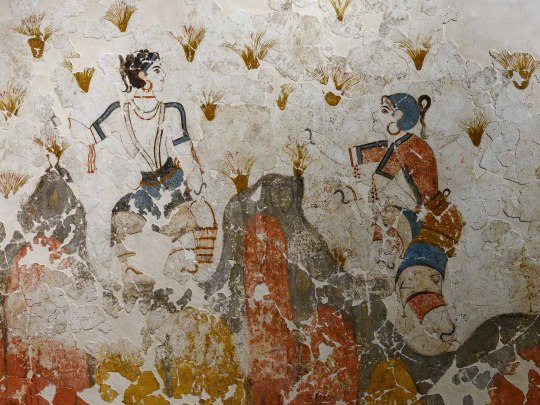
Another option is leaving the fringes loose, as seen in the Akrotiri frescoes from Xeste, room 3:
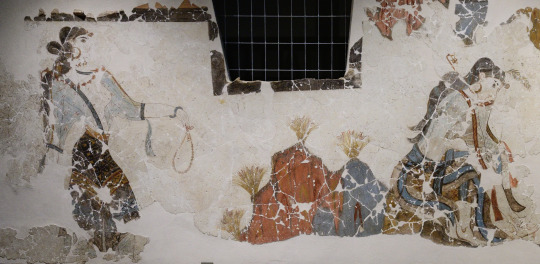
The final garment was super comfy, actually! It's much simpler to create than I thought it would be based on the frescoes, which made it all feel pretty magical when everything came together. I did think it was a little unusual how tailored this garment is, and the potential waste of fabric that comes from a shaped garment, especially compared to how later ancient greek clothing was mainly rectangles. I don't know enough about bronze-age and earlier clothing to have any idea how typical this was, since I'm extremely Not an expert on this subject, but am always open to learning more!
500 notes
·
View notes
Note
What is the fashion like in your world?
Oh, what a fun question!
It’s taken me quite some time to get to since I had to think about fashion in parts of the world not immediately shown in the beginning of the story and consider more details that I hadn’t previously thought of.
Just like in the real world, the fashion and clothing styles vary a lot depending on the different regions and cultures.
I'll mainly focus on the fashion of Aíos, which is the country where "Unsanctioned" takes place, though I'll also touch on the nations of Ciralor (Azora's homeland) and Ekkeran.
Aíos
The vale where the MC spends most of their childhood is ever cold and bitter, reminiscent of Ekkeran, though the rest of northern Aíos doesn't suffer this unending, unnatural predicament. Clothing focuses on practicality; partly due to the shifting temperature and partly because this part of the land is situated closer to the wilderness and thus remains more at risk for impromptu visits from forest creatures.
The clothing among the less well off is constructed from repurposed, hard-wearing materials like thick felt and wool. Garments need to be durable enough to withstand the rigors of manual labor, unpredictable weather conditions and frequent mending. Earthy tones and muted colors are common due to the limited accessibility of expensive dyes.
In order to add a hint of elegance to their clothing, people can sometimes be seen with hand-carved wooden buttons, bead embroidery and cord work.
Thinner fabrics often come in layers in an attempt to create the illusion of grandeur despite humble means. In general, the focus tends to be on clean cuts and minimal ornamentation.
Old clothing items are at times repurposed and transformed into new pieces.
Talzaric – Aíos’ capital – has a considerably warmer temperature, but that doesn’t mean that the aristocracy doesn’t choose to suffer for the sake of making an impression.
Most wear loose velvets, silks, and satin. Rich jewel tones like emerald green, sapphire blue, and ruby red can oftentimes be spotted accompanying neutral whites and creams. Most wear flowing, floor-sweeping gowns with intricate embroidery, lacework, beading, and metallic thread embroidery. Tooled leather belts cinched at the waist is quite popular, sometimes paired with flowing cloaks draped elegantly over one shoulder. Feminine attire often contains tulle underskirts while masculine fashion incorporates waistcoats with patterned silks and rich brocades, complete with pocket watches dangling from intricate chains.
The motifs of the embroidery ranges from house to house, precariously balancing between a chance at standing out while making certain to fit in with the crowd. Mosaic patterns and motifs inspired by frescoes can often be seen on skirts, coats and cloaks. Dresses sometimes feature layered, petal-like sleeves and intricately carved wooden accessories along with more valuable jewelry.
Headwear is commonly used regardless of social status. Laurel wreaths, feathers, bonnets and hats often serve as miniature works of art, ranging from practicality to whimsical fashion statements.
Ekkeran
A quiet, looming kingdom to the far north. It's not uncommon to see the northerners with weapons strapped to their belts, clad in robust furs, wool (dyed or not) and intricately stiched leather from various animals. Their clothes often contain hidden pockets created to store various objects meant to preserve warmth. Their clothing is nothing if not practical, even among the so called ‘nobility’. Survival takes precedence and precious few have time to consider beauty in the harsh environments that Ekkeran presents.
That doesn’t stop people from adding their own personal touches to the clothing or hair, however. Different types of shaved hairstyles are popular among the Ekkerans, sometimes in patterns depicting symbols that hold intimate meaning. Some people wear discreet, meaningful tokens woven into their clothing or accessories passed down through generations. It’s popular for sweethearts to exchange wooden charms that can be carried close to the recipient, unperturbed by the harsh elements.
Materials play a crucial role in daily life. Textiles, while first and foremost serving the role of protection, allow for subtle pattern variations that become a form of non-verbal communication such as knotwork or frost-patterned fabrics that convey social status, occupation, and allegiances without drawing unnecessary attention.
Personal amulets and talismans are essential to the Ekkerans. These are often worn close to the heart in order to grant protection against the foul magic that plagues their lands.
Seemingly mundane objects such as lanterns, cooking utensils etc. sometimes hold hidden, carved symbolism such as milestone events or cryptic warnings that would remain a mystery to outsiders unfamiliar to Ekkeran customs. Over time, it’s become a game of sorts to leave riddles and trying to figure out the meaning of these carved secrets.
Ciralor
As a nation that prides itself on innovation and tradition alike, Ciralor fashion often consists of contrasts; such as delicate silk embellished with brass filigree and intricate clockwork mechanisms.
Hanfu-inspired garments, sometimes with Mandarin-inspired collars, merge with bustles, corsets and obi belts cinched at the waist, adorned with steam-powered automatons and delicate gemstone-studded cogs.
In terms of accessories, wooden fans are often etched with tiny gears, worn as brooches and adorning hairstyles. Jade jewelry can be found infused with minute clockwork components that whir softly. Their shoes are sometimes curved soles reminiscent of traditional geta sandals, adorned with copper piping and steam-powered pistons.
26 notes
·
View notes
Note
Hello lovely! What about est relationship + borrowing clothes? Maybe Draco wearing Harry’s shirts or jumpers? Could be as fluffy or smutty (or both) as you want 💗 - sitp
thank u liv for this lovely prompt. fair warning: buckle your seatbelts for the not one but two sets of parentheses within another set of parentheses.
i was tragically torn between soft and smutty in this one. we’ve ended up with kind of both and kind of neither — enjoy 😔
explicit(ish), 1389 words
The first time, Draco takes Harry’s jumper. It’s his, his favourite, knitted by Molly and given to him when he was twenty years old. It’s blue, and has a whale on the front in a deep navy tincture (the noughties were when Molly entered her experimental phase — instead of letters, everyone's Christmas sweater bore some kind of (no offence, Molly, but utterly random) image. Ginny’s had a platypus on it, Percy’s had yew branches up the sleeves, and Ron’s, an impressively detailed Muggle toaster (??) across the chest.)
Whatever. Logic aside, Harry loves his jumper, and he loves his whale, who Ron dubbed Herbert towards the befuddled, tipsy end of the night. (“Herb for short,” he said, and then collapsed into his eggnog.) He loves that Molly chose it for him, the Warming charms entwined in the wool that feel like her fierce, protective magic against his skin, and the way it’s become loose and pliant with age.
Unfortunately for Harry (and Herb), Draco likes the jumper too. Likes it so much that he sees fit to employ every Slytherin-y wile in his arsenal to try and steal it.
“I don’t understand why you covet poor Herb, Draco,” Harry says, when he goes looking for the jumper and finds it missing from it’s drawer again. “I would have thought him nowhere near sophisticated enough for your tastes.”
Draco sniffs and rolls onto his stomach. “I’m sure I haven’t a clue what you’re on about,” he says, and manages to sound lofty even with his face half buried in a pillow.
* * *
The second time, Harry takes Draco’s tie. It’s a silvery grey one that’s the same colour as his eyes, a custom made gift from Pansy for his last birthday.
And Potter, the cheeky fuck, has stolen it. A looter, ruthlessly purloined it in an unscrupulous heist, that he’s probably been planning ever since they first started dating, or is it why he even pursued Draco in the first place(?!), just to whisk it away from everything it knows, and—
“That’s quite enough,” Harry says. “And I didn’t take your tie.”
Draco slams his hand down on the kitchen bench. “Lies! Fraudulence!—”
“—I took ransom. You’ll get your tie back when you return my son.”
Well. Well! Draco pretends to dust lint from his sleeve. He says, cooly, “Herbert prefers my company, anyway.”
“He does not.”
* * *
The third time, Draco takes Harry’s Muggle jeans.
And he’s a ferrety little ferret faced liar, because he’s complained about the jeans in question since the first time he saw them.
“How did you get the knees so dirty?” Draco said. He looked the picture of aristocratic disdain with his nose all crinkled up like that. “Have you been sucking cock al fresco?”
“We’re coming back to that,” Harry had said (and they did), and then shut Draco up with a nice, long snog when he started on the rips and the faded denim and the fit-so-tragically-loose-I-can’t-even-see-your-arse.
And now Draco is wearing them, slung low on his hips as he shrugs off his coat.
“You fuck,” Harry says, partially because those are his and Draco is an insufferable hypocrite, and partially (mostly) because the jeans are so big around Draco’s waist that Harry can see the cuspated jut of his hip bones and the little silver ring in his navel.
Draco looks down, all feigned innocence. He says, “Don’t you think they suit me?”
Harry mutters, “I’ll suit you in a bloody minute,” and pulls him by the wrist towards the men’s, where he sucks him off so hard and fast that Draco bites the crook of his elbow till it bleeds.
* * *
The fourth time, Harry takes Draco’s slippers. And Draco’s feet are cold.
“Those are mine. Mine,” Draco tells Herbert, looking down at his chest as he shuffles around his cold flat in the thickest socks he could find.
He knows he’s not exactly a sentient being, but Draco would like to think Herbert looks sympathetic all the same.
The rugs on his tiled floors are for purposes more aesthetic than comfort — it’s bloody cold in the mornings, and without Harry to tangle his legs around or order to the kitchen so he doesn’t have to brave it himself, he needs. His. Slippers.
The thing about it that’s most troubling, really, is that, was Draco less of an idiot (Pansy’s words) who had just chosen floorboards for his flat and not mosaic tile (because he lives in Britain and not fucking Madrid, so on,) he probably wouldn’t mind that Harry has pilfered from him yet again.
Harry’s stopped asking for his jumper back. Or rather, extorting Draco until it’s returned. And Draco’s content in leaving his tie wound around the wrought iron posts of Harry’s bed, and Harry thinks his jeans look better on Draco than they ever did on him.
It’s hideous, really, because Draco has never even liked sharing (Draco does not share, in fact), but somehow he’s ended up with a wardrobe that’s more Harry’s than it is his, and the black trousers that flatter his arse so brilliantly are gone, and so is the faded Quidditch jersey he only wears when he’s ill. And he doesn’t even mind, because he knows when he goes to Harry’s flat he’ll find it all stuffed into the antique dressing table drawers taken from Sirius’ room at Grimmauld Place, smelling like Harry and his warm, sapid laundry soap.
Draco says to Herbert, “This is your fault.”
* * *
This time, Draco takes Harry’s dressing gown. He’s wearing it when he emerges from the bathroom, water still sluicing off the delicate ridge of his nose, off his hair and down his back because he never dries himself properly. (I have sensitive skin. I’ll break out in hives. Harry knows it’s just an excuse to lounge naked on the couch while he “air dries”, but whatever.)
“You’re dripping all over the carpet,” Harry says, leaning on his palms against the door frame of his bedroom.
Draco says, looking around at him, “Ah. My sweet. I was just coming to fetch you.”
“Why?”
“I’ve drawn us a bath,” says Draco.
Harry had planned on making some tea and watching Come Dine With Me, perhaps Floo calling Ron and Hermione to see how the renovations on their flat are coming along. But Draco is all wet and warm and glossy, and smelling like the expensive bubbles he refuses to bathe without.
Harry lets Draco lead him to the bathroom, where the floor is wet with his footprints and the air is thick with perfume and soft, cradling breeze from the cracked open window.
“This is my dressing gown,” Harry says, stepping closer so he can slide it from Draco’s slight shoulders.
Draco reaches for Harry’s flies. “And these are my knickers, you troll,” he says, and hooks his thumbs into the waistband.
Once both disrobed (Harry’s shirt flung over the counter, the pilfered dressing gown puddled on the floor, both of them hard and flushing) they step into the bath. Draco likes the water scalding despite his dainty skin, but he must know Harry prefers not to be boiled alive because it’s just sultry, just warm.
Gold fretted shadows slide over Draco’s face as they settle, legs tangled at the knees, Harry tracing shapes around the delicate knob of Draco’s ankle.
Harry feels elastic in the water, melting with pale, gauzy limbs draped all over him.
“C’mere,” Draco says. “I want to wash your hair.”
When Harry hands him a bottle, he says, “Not with that utter swill. Mine.”
Draco means his shampoo, but Harry knows he means him a little bit, too.
A soft, pleasurable thrill runs through him. Harry loves the smell of Draco’s shampoo. He thinks it smells like wide open spaces, like walking over the crest of a hill. He also thinks it smells a bit like spices, like star anise and cinnamon, and lemon zest and sage. The scent on the bottle reads Cedar, which, okay. Fine.
Draco uncaps it, squeezes a pearlescent puddle into his palm. He sets himself on Harry’s lap, and takes his cock slowly, sweetly, chest to chest, with his fingers twisted in Harry’s hair.
Harry rocks him in the water, his head bowed into Draco’s collar bones as he laves and rinses, soft and soft and slow.
* * *
most important things in my life (in ascending order)
friends
family
harry being hot for Draco in low slung trousers
draco having a belly button ring that is exposed in said trousers
348 notes
·
View notes
Text
After You Buy All the Essentials, Then What? My Personal List Moving Forward
Switching focus from the urgent to the important is a vital practice in the business world. Have you ever worked somewhere where it’s clear that instead of thinking critically about the core of the organization’s mission for ways to grow and improve, the focus is instead on whatever the newest, shiniest idea is (or often, whatever the latest crisis is)?
I always had a sense of urgency about buying clothes, because my goal was to dress in cool tailoring every day of the week in ways that I would consider meaningfully different. But being constrained by a budget meant I had to think carefully about what I bought, so I wouldn’t end up with something because it was a great deal, only to discover I had very little use for it. So I created a list of clothes I wanted that I imagined would comprise a complete wardrobe (for my tastes and needs). That helped me stay focused on my goals when sale season started and there were so many awesome things to buy.
Now, though, having largely built that wardrobe I imagined, I tend to get distracted by the new, shiny thing much more. I’ll find some product on eBay or in a shop on sale and become obsessed with it, going back to look at it over and over again. Without that hit list of must-buys to bring myself back from the brink, I always have a creeping sense that whatever it is I end up actually purchasing is maybe the wrong choice for me and I should instead be saving that money for some other, better purchase down the road. I’ve picked all the low-hanging fruit, but I have no personal guidance for reaching higher.
So, in an effort to try and refocus myself on buying what I can consider important purchases—not just those with the urgency of desire—here’s my list of next must-haves.
(By the way, if you’re just starting out and want some help building a wardrobe from scratch, check out my “Guide to Building a Tailored Wardrobe.” In it, I explain just that—how to have the right mindset about buying clothes, plus specific advice for versatility in clothing. Check it out here.)
More cotton-linen trousers for summer
Since becoming a dad—but even before then—dress trousers in wool just don’t get much wear from me. Primarily that’s because pants need cleaning more often, and I hate dry cleaning bills. But it’s also because I prefer a silhouette that just doesn’t work with dress pants, at least in wool. Jeans or even chinos made of denim or cotton twill drape differently and thus can work in the tapered cut I prefer. My previously perfectly fitting flannel trousers with that ideal taper from Spier & Mackay are now too slim because my calves got too big. So I have to go fuller. I’m fine going with that in a drapey wool, but day to day I prefer a slimmer knee and slightly tapered opening at the hem.
This is why cotton-linen trousers exist. Cotton-linen seems to have that perfect balance of cotton’s stiffness with linen’s drape, so they hang well but are forgiving if the fit isn’t bespoke-perfect or your proportions make things difficult. Pure linen just doesn’t give off the vibe I’m looking for typically (it feels a little more louche the way it hangs and rumples than I as a person am). And other options like wool-silk-linen blends are beautiful and amazing (I’ll get those below), but what I like about cotton-linen is I can usually machine wash it myself to no ill effect. Currently I have one pair, so it’d be nice to get another 2-3 to rotate through (much as I have with flannel in the winter). My list would be:
A second pair of off-white
Tan / khaki
Deeper brown
Maybe a light blue or mid-navy
Options I have for buying these: Spier & Mackay’s dress trouser fit is still my best bet right now, and I’ve been told they’ll have a crop of 7 colors of cotton-linen trousers in mid-April. That said, I also just purchased some pairs from Brooks Brothers’ Red Fleece line that arrive soon, made from fabric by the same mill as Spier’s, for $37 a pair that might work, too.
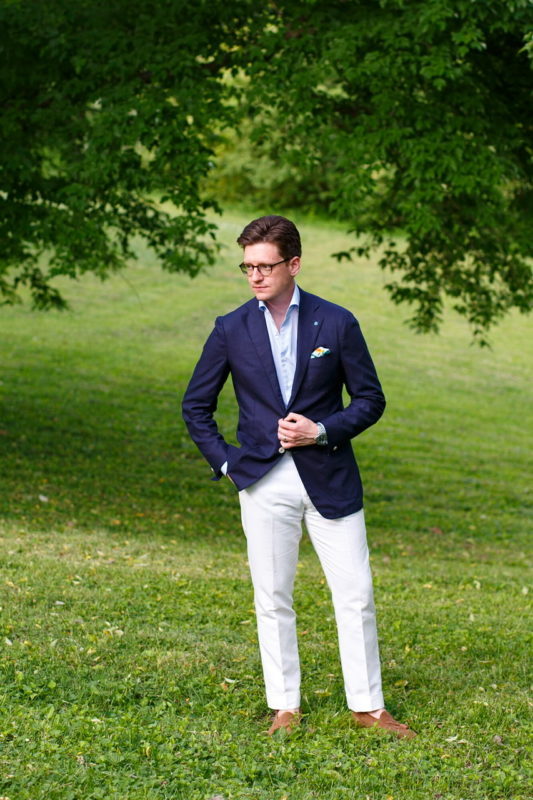
A rotation of good chinos and a pair of light wash jeans that fit
Chinos are nice because they dress up or down pretty well (you can wear a tie with them without it being weird, unlike five-pocket pants, but on their own without a jacket they’re good too), and if you get them in the right fabric, they’re pretty hard-wearing.
Finding chinos that 1- don’t have stretch, 2- are made from material that’s a good mid-weight, and 3- fit the way I want is extremely difficult. You wouldn’t think so but man it’s hard to find good chinos. And finding good, faded jeans with similar qualities is likewise hard without spending $200+. That said, if I can find them, what would make my wardrobe happy would be chinos in:
Off-white
Stone
True khaki
Possibly a pair in fatigue, which is a good color when it’s too hot to wear a jacket
Options for chinos are tricky. I like the idea of what fellow menswear blogger Ian is doing with his new shop Lost Monarch; $125 is hefty for chinos, but I suppose if they fit really well and the fabric rules, the investment might be worth it. I also always forget about classic chino maker Bill’s Khakis, which was always hailed as having the highest quality back in my early Styleforum days. They introduced a number of slimmer fitting styles over the years and are still fairly easy to find on eBay. Spier & Mackay’s chinos are a great deal but each time I’ve tried them, the fit’s been off for me in some way or other. I might try them once again this spring.
As for light wash jeans, I’ll be looking probably at American Eagle, Polo RL, Abercrombie, Banana Republic, and other mall brands. Much as I’d like to get some 3-Sixteens or even Naked and Famous, they’re hard to get ahold of where I live and trying jeans on is critical.

A dark navy blazer in both single and double breasted configurations
I have seasonally appropriate navy jackets—one is wool/cashmere for winter, and one is raw silk for summer—and last summer I added a dark blue double breasted jacket for summer as well. When I recently tried on No Man Walks Alone’s Sartoria Carrara jackettried on No Man Walks Alone’s Sartoria Carrara jacket, which was a dark navy twill, I remembered why dark navy jackets exist: they’re classy as heck. All my navy jackets are slightly lighter shades of navy, which is great, but a good, dark navy blazer brings some gravity to an outfit, looks great in the evening and dresses up very well for more formal occasions.
That said, it’s gotta be the right texture. Hopsack wool is a good option; I would also be interested in some kind of blend like wool-silk-linen or similar. I’m not a fan of mohair, so I wouldn’t do that, and the high twist fabrics are tricky because they tend to look fairly smooth, while I like a little more surface texture. Given how much I like my SuitSupply Jort blazer, I’m hoping they release a double breasted jacket that might fit the bill this spring/summer. As for single breasted, I really, really liked that NMWAxCarrara jacketNMWAxCarrara jacket, so something closer to a 3-season fabric from him would be amazing. Of course Spier & Mackay has staple hopsack wool blazers in both their Neapolitan cut and regular cut, which sold out quickly in my size.

A dark navy double breasted blazer by Ring Jacket (model 6) I tried on at The Armoury in New York City. Click the image to see the product page of this actual jacket at their site.
A pair or two of summer trousers in a nicer fabric
Cotton linen trousers and chinos are as dressy as I need them to be most of the time in my life, but it’s still nice to have a pair of classier dress trousers in summer for occasions that call for it. I’ve had gray hopsack and fresco in the past, but those were more corporate than I was looking for.
Summer is the time for levity in the color palette, so I really like the idea of a light or mid blue (maybe a petrol blue). Every time Greg at No Man Walks Alone does spring pre-orders for Rota, they offer these beautiful wool/silk/linen blend fabrics, including petrol blue in the past, and every time, I love how they look but always stopped short of ordering for various reasons. A sufficiently textured, interesting blend in a light gray would also be nice and would be better than a corporate looking fresco or tropical wool. In the swatches below, which were for this season’s Rota trouser made to order options, the blue and gray at the top hold appeal, and even that green at the bottom.

Swatches for Rita wool/silk/linen trousers From No Man Walks Alone.
Some dress shirts from Anglo-Italian
It feels like I’ve been banging on about this for years at this point, I know, but their reverse stripe OCBD is great and I need to just pull the trigger and buy it. But beyond that, Anglo’s house dress shirt model is essentially the perfect shirt: the collar shape is an ideal wide spread with no tie space and that isn’t too stiff; the fit is comfortable but not baggy; and the details are all there both quality and design-wise. The back shirring is maybe a bit out there for many people, but these shirts are meant to be worn under a jacket, which is how I’d wear them. I’d buy white first then probably their blue end-on-end and maybe the bengal stripe. They’re expensive at $175, but that’s less than other comparable Italian dress shirt companies like Finamore or Borrelli.
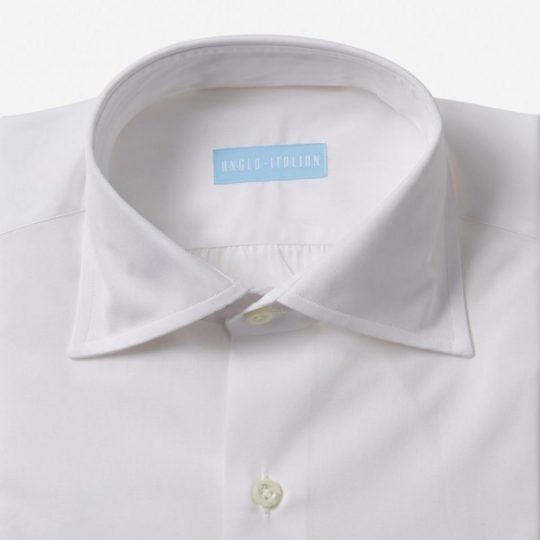
A couple additional pairs of suede shoes
I love suede for its versatility in dressing up or down. What I wear 95% of the time are snuff suede penny loafers, snuff suede chukkas and tan suede tassel loafers. I’m looking to get more dark brown suede, which, sorta like true dark navy blazers, brings some gravity to an outfit. My penny loafers have been through some rough times; I plan to resole them (which they badly need), but it’d be nice to have a pair that aren’t so beaten up. I prefer a sleeker last shape most of the time (not pointy, maybe almond shaped) to the round lasts you see from classic Ivy brands like Alden, which are more casual and carry a lot more of that Ivy feeling (something I’m always trying to temper with more rakish aesthetics). That said, a rounded loafer of some kind to wear strictly casually is something I’d like to get to help share the load with the other shoes. I’ve also been really into the split toe derby look the last year or so. I tried The Armoury’s on when I visited there in 2018, and really liked it.
So, the list would be:
Dark brown suede penny loafers
Dark brown suede Chelsea boots
Brown suede split toe
Dark or mid-brown suede beef roll or similar more casual loafers
I’ve noticed that the most comfortable shoes I love wearing the most are all made by Allen Edmonds, so I’ll be looking at those for sure. The Sea Island in particular looks awesome for that casual loafer. Beckett Simonon has some suede boots and given how comfortable their shoes are, their Bolton Chelsea looks nice. Meermin of course is another option for suede boots, and they have a penny loafer that might fit the bill for me, too. Spier & Mackay’s shoe offerings look very good, including this suede penny loafer. And of course the Armoury’s split toe derby is the one I’m most looking at for that category as I’m sort of picky when it comes to split toe shoes.
So there’s my hit list moving forward. I’ve already deviated from it this season by purchasing an excellent but not-on-this-list jacket from Spier & Mackay in 100% linen by Sondrio in a mid-brown glen check pattern. It surprised me how much I loved it, so I’m letting myself deviate from the list, guilt-free. And at the end of the day, the clothing hobby is all about enjoying life anyhow, and what could be more important than than?
(Help support this site! If you buy stuff through my links, your clicks and purchases earn me a commission from many of the retailers I feature, and it helps me sustain this site—as well as my menswear habit ;-) Thanks!)
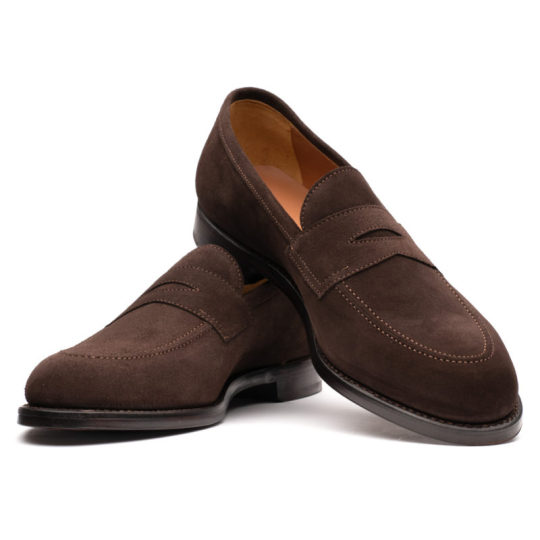
Read more at Menswear Musings
10 notes
·
View notes
Text
Saturday, 1 March 1840
8
2 40/’’
Long in washing &c. Reaumur 12 1/2º on my table at 10 a.m. breakfast over at 11 – Reading Schnitzler vol.[volume] 2 p.[page] 684 et seq. Government of Saratof – Had our landlord up – No steppe on this side the Volga – No Eaux Minérales here – They are at the Caucasus – To go to Orenburg, must return to Simbirsk –
500 v.[versts] from here to Uralsk the Eboulement – There was one in 1827 – One 3 years ago 2 v.[versts] from here – A brandy distillery slipped away – Only a brewery left there – The village is removed – Belongs to Government – The slip last summer was at Féodorofka 250 v.[versts] from here on the great road to Astrakhan no lives lost – 50 or 60 cottages slipped away –
Mr. Stalepine has no verrerie here - No Tatar mosques or schools here – The Botanic Garden on the hill that we passed yesterday at 1st supposing it a vineyard – Mulberry trees there – These were what we took for vines in the distance but on nearing them (never very near) they looked like orchard trees – about 30,000 inhabitants – Trade in fish and caviar – Had just written so far at 12 55/’’ –
Out at 1 1/2 A-[Ann] and I in a Traineau and pair (good horses as at Kazan) along our Street Rue de Moscou, some distance – Then turned right, along the street where the post office is, and then into the Great Astrakhan road for some way, and then left this and drove another road by which one goes to A-[Astrakhan] in summer, and then to the Botanic Garden! – A quiz upon Botanic Gardens if this be one – The serres that Schnitzler mentions are a small wooden erection heated certainly but only for a few hydrangeas oleanders geraniums and 1 or 2 species of huddled together on the floor there was also viburnum a few bulbs or onions – And in the lower part lettuces just come up – There must be some other Botanic Garden but the German colonist living there and inspector of the Silk Thread Manufactory a little building near, declared there was no other garden belonging to la ville – He shewed us a specimen of the silk thread – Yellow and white – Pretty good?

The cheerful sleigh-ride by Pjotr C. Stojanow (Image Source)
Good road here a day or 2 ago – Now snowed up – Our horses lunged sank deep (several times) and we had to get as we could up to the house – Returned past the prison a large building full of people for Siberia – Our barrier that we entered by close by – We kept outside and drove along the Old Town – The Rue des Tatars down upon the Volga close to the great ravine which parts the town in 2 and in the bottom of which several brick-ovens and sheds – But saw nothing of the old rampart that Geography Dictionary speaks of –
On getting upon the river drove Northwards to see the mountain slip of the last summer – It is a little beyond (North) of the 4 lines of Magazins à Sel – The Sokolof Mountains aboutissent, and a bit of the end of this sandy range slipped off its marly clayey bed in the great heat of August last (said our driver) – And just beyond this (North) was the larger slip in 1827 – A mere Isle of Wight landslip – No lives lost – Then at 3 1/2 drove across, 5 v.[versts], to the Pokrofsky Slobode in 1/2 hour –
Drove to the Salt Warehouses (near one one of the 3 good churches in this village of peasants belonging to Government) – A crowd of Drovnis – Busy loading with the salt – Sells here at 1/40 per pood and at the lake itself the people gather the salt themselves and pay -/80 per pood for it – All broken pretty small – In very coarse grains – Looked like a coarse dusky gravel – But good salt (tasted it) and in this state the peasants use it; but if they want fine salt each can easily refine for himself by means of alum –
Then drove about the village – Went in to one of the little Isbas – Apparently one of the worst – Very small – Always 2 rooms however small or they could not keep their living place warm enough the entrance room or vestibule is a sort of receptacle for everything – The inner room entered by a little low door that we had to creep in at, has the oven stove and shelf over it, the bench and a table – A white calf lay by the stove – The man of the house on the bench in his dark coloured shirt, and a young girl or 2 on the stove – Just room for all these people to turn themselves and not much more – The wife was not at home – The man put on his Shube, and came out with wondering why we should trouble ourselves to peep into such a place – He looked pale – How could he do otherwise – The heat and smell of the little hot place were intolerable – But this man at his ease – 3 cows – A horse – Some sheep, geese, pigs and poultry and a couple of Telegas, and a willow wattled round farmyard like all the rest of the people – Not a cottage without the like appurtenances –
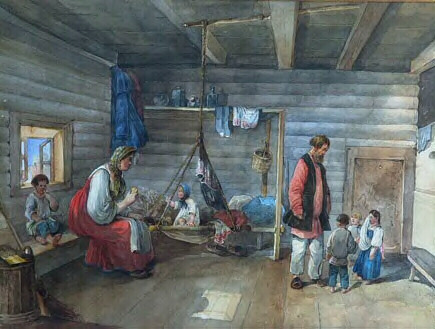
Interior of a Russian Peasant Izba by Karl Kolman (Image source)
The village has a striking appearance thus full of wattled enclosures a great out-buildings for the cattle and many of the huts of this sort of wicker work mud-plastered over – Passed near to each of the 3 good churches and went into one of them – Vespers – Full of Shubed people – The service well chauntered – Beautiful singing – I could have staid longer but A-[Ann] was cold and anxious to be off – We had put Reaumur on the snow a few minutes before, at 4 1/2, and it stood at only -7 1/2º - but there was a cold wind – The church all painted in fresco was even handsome seemed spacious for a Greek church the nave from the belfry and the great dome being all church – The prestole in the Apsis behind the dome – Square tower clocher, nave, dome, apsis – Such is the style of church here and all along since Kazan – The 5 dome-churches are rare hereabouts, and the little domes when they exist are mere reminiscences – Little things like 4 chimneys –
Very cold wind in our faces as we returned, and the snow blown up and driven about us – Returned up our street (the main street – Rue de Moscou), but turned left to see the large cathedral planted round at a little distance with trees (young) along a nice walk here is the Senate House – The large handsome house of Ivanof the Seigneur chez qui the Emperor stays when he comes – The clocher, at a little distance, is only about 1/2 built – The church is finished and has been finished did the man say 12 years – A largeish square finished in an inscribed circle of 2 grades from the highest of which springs the large handsome dome – Towards the clocher (West?) there is a hexastyle? and pediment – Opposite (East?) is one Apsis – The other 2 sides have each a hexastyle with architrave and cornice without pediment – This church standing on high ground is seen from far the most massive building in the town – As strikingly huge and massive here, as the new Town Hall is at Birmingham –
Came in at 5 1/2 M.[Monsieur] and Madame Stalepine had called – Disappointed not to find us at home – Had invited us to dinner tomorrow at 12 – At noon! The Courier and Gross declared it was so – And they would send their carriage but had promised it yesterday to some friends – A great ball of the Noblesse tomorrow night –
Ordered 2 horses to be put to our own Kibitka – Had the Courier and George – From here to Astrakhan the posting sans pour boire = 280/- - to give the Courier 400/- tomorrow – He is to inquire if there is a road from here to Uralsk – The distance – Road from thence to Orenburg and distance – From where to turn off to the Calmuck Encampment &c. &c. –
Dinner at 6 1/2 – A bottle of red Donskoi 1/- sweetish and pleasant and a bottle of white Champagne-like Donskoi 3/- as yesterday – We finished the bottle as yesterday and sat over it till 8 – Then lay down for a few minutes –
Could not be more than 8 1/2 when Madame Stalepine called and staid till 10 – Talked very agreeably – There is a better Inn than this – The Hotel de Petersburg – I said the Courier managed all these things – To dine at 4 p.m. tomorrow and the carriage to be sent for us – Mr. S-[Stalepine] has 4000 peasants – One village = 1000 – Connoisseur in sheep – Has made a contract for 10 years with a Mr. Cowley fermier from not far from London who pays 1/2 expense and ∴[therefore] takes 1/2 profits – M.[Monsieur] S-Stalepine finding, I conclude, the pasturage – Has 60,000 arpens of land – Mr. Cowley has sent over an English shepherd who brought his young wife with him – Arrived at St. P-[Petersburg] in June last and here in September – The sheep by water to St. P-[Petersburg] and ditto from there here – Mr. and Mrs. Cowley were here 2 or 3 months last summer he delighted with the place and would have been glad to remain here –
The terre where the sheep are is 10 v.[versts] from the next Station from here on the Simbirsk road – Not far ∴[therefore] from Volsk – We at our last Station were 10 v.[versts] from our compatriot shepherd and our English long fine wool sheep – One ram cost 600/- and one Ewe 200/- Mr. S-[Stalepine] had 400 from England and several others of the Russian nobility of St. P-[Petersburg] and elsewhere had sheep of the same kind so that a large flock must have come – Madame S-Stalepine has 3 children the oldest Æt[aetatis] 5 – 2 girls and a boy – Looks young – And prettyish – Very civil –
Tea after she went away – Then reading Dictionary Geography till 1 and then till 2 10/’’ wrote all but the first 13 lines of today – fine day but cold wind and cold this afternoon after between 2 and 3 p.m.
[in the margin of the page:] Pokrofsky
[in the margin of the page:] Reaumur -7 1/2º at 4 1/2 p.m. dehors
Page References: SH:7/ML/E/24/0028 and SH:7/ML/E/24/0029
2 notes
·
View notes
Photo






Our Beloved Sponsors
Put This On is made possible thanks to the support of our sponsors. They help us keep the lights on, so twice a month, we like to give them a special shoutout. It allows us to show our appreciation, as well as check in with their latest happenings.
Over at The Hanger Project, you can find a new assortment of sweaters from John Liang and William Lockie -- two of the most respected names in traditional Scottish knitwear. The pullovers and cardigans are densely knitted from multi-ply yarns, which means they have an appreciable heft and will keep their shape over time. Lower-end sweaters are typically knitted with a lot of slack and/ or made from short-fiber yarns. That allows the producer to cut costs in a way that isn’t easily discernible when the sweater is new, but the sweaters will quickly bag out and pill after a season. John Liang and William Lockie’s sweaters, on the other hand, are made to last for years.
Our friends at Proper Cloth specialize in made-to-measure shirts, but each season, they do a lookbook to show how their fabrics can be worn. This season, the team flew all the way to Scotland for their presentation. In front of a backdrop of stone gray castles and mossy green hills, Proper Cloth shows how their muted flannels and chambray shirts can be teamed with denim, as well as their dressier poplins and twills be used with suits. Below is a video they produced to give people a behind-the-scenes look at how they shoot their lookbook. It’s ... kinda Steven Spielberg-esque.
youtube
Paul Winston over at Chipp Neckwear continues to offer some of the lowest prices around for neckwear. In addition to his ancient madders for fall and silk Matkas for summer, he also has Italian knit ties you can wear year round. A little floppier and more casual, they designed to be worn with tweed sport coats, linen suits, and navy blazers. It may be counterintuitive, but black here will be your most versatile option. The color allows it to go with anything, while the weave makes it casual.
Dapper Classics is also getting into the grenadine business (sorry Paul). Theirs are a bit more expensive, but they also have some colors not found at Chipp, such as a mid-blue and bright orange. The team also just did a big restock on their popular trousers, which are made by one of NYC’s best garment factories. These have a mid-rise and slim leg line, and come in a wide range of fall/ winter fabrics, such as lambswool Donegal and brushed cotton. There are also some Minnis Frescos in there, an open-weave tropical wool that’s popular with customers of bespoke tailors.
For the next week or so, Huckberry is stocking Gola’s sneakers. These retro-styled runners take after British sportswear from the 1960s and ‘70s, back when Gola was famous for their running shoes and messenger bags. Huckberry has the Track Suedes in navy and gray, as well as the Harrier 317 in brown and white. They shoes are made in England can be worn in that ‘60s and ‘70s Rugged Ivy style we’ve written about. Huckberry also has some gift guides, if you need suggestions on what to get a friend for the holidays.
Finally, our thanks to Twillory. They’re holding an early Black Friday sale (their best prices ever). Get two shirts for $89 with the checkout code SAVE2; four shirts for $169 with the code SAVE4; and five shirts for just $199 with the code SAVE5. Their shirts are slim fit and come in a range of basic and slightly quirkier fabrics. Shipping and returns are free, which makes trying out something easy.
If you want to advertise on Put This On, just email us at [email protected].
7 notes
·
View notes
Text
Ancient Greece (Part 15): Decline and Recovery (c.1150 - 900 BC)
The strongest evidence for Greek decline after 1200 BC is that there are almost no expensive, finely-made artifacts in the archaeological record. However, painted pottery from after this date is still relatively abundant, it is used to follow Greece's decline & recovery. The Dark age periods are named after the stages of pottery shapes & ornamentation. The Greeks continued to take the art of pottery & painting vases very seriously, which is very helpful for us.
Submycenaean Period
The pottery from c.1125 – c.1050 BC is called Submycenaean. This is because it is still in the Mycenaean style, but the quality is far lower. This historical period was the aftermath of the attacks, and the low point of the Dark Age.
The Submycenaean pottery style has been called a “style of exhaustion”. The potters used very few of the wide array of shapes & decorative elements that their ancestors had used. The clay is often poorly-prepared; the vessels are smaller, less well-formed, and poorly-fired. The traditional motifs and decorations are rather clumsy.

Submycenaean octopus jar.
These vases are nothing in comparison to those of the 1200's, but they are the main wealth of Submycenaean graves. Nothing else valuable was buried with people, except for occasionally a gold ring or bronze dress pin. Even the pottery itself wasn't abundant in burials. For example, 220 graves in Athens & Salamis had only 160 vases between them, and these places were not destroyed or abandoned.
Population levels had dropped dramatically all across the Greek world. Estimates vary (according to region) from 60-90% decrease. Melos (an Aegean island) was heavily-populated in the Late Bronze Age, but for the 200yrs seems to have been nearly empty. Even in Attica, a region that was not successfully invaded, the number of settlements dropped by 50%. At the end of the 1000's [century, i.e. near 900 BC], the population in Greece was probably the lowest it had been for a millennium.
This population decrease seems to have been connected to the collapse of the redistributive economic system, and the general economic lag in Greece at the beginning of the Dark Age. Large movements of people would have caused unstable conditions, and were often accompanied by violence. This would also have contributed to the population decline.
However, it is important to remember that migration/relocation can give an exaggerated impression of population decline. Some of the smaller Bronze Age settlements were deserted because the people simply moved elsewhere, where it was safer. Tiryns' population actually increased after 1200, because of refugees. Also, a lot of people fled to Achaea and Arcadia, and other more lightly-populated regions. Others went overseas.
The centralized political/economic organization had disappeared with the palaces. The powerful wanax and his subordinates – officials, scribes, workers – who supported the redistributive system were gone. Within a few generations, almost all knowledge of them had disappeared. There was only the memory of great legendary warrior-chiefs, powerful rulers of large, prosperous kingdoms, who had been better men than their descendants in every way.
But Greece still hadn't collapsed into a completely primitive state. Daily life for the ordinary people, at the household & village level, continued on as before. The people grew wheat, barley, olives, figs and grapes. They herded sheep, and spun & wove their wool & flax, with the same equipment & techniques as before.
The potters, carpenter-builderss, metalworkers and weavers all kept their basic technical knowledge, too. There was no longer demand for fancy goods or fresco paintings, which had disappeared with the palaces – central manufacturing, storage and distribution were no longer in place, along with luxury goods, trade, and tax collectors. But the usual agricultural life continued on.
In the same way, religion during the Dark Age both continued and changed. 6-7 of the later 12 Olympian gods are found in the Linear B tablets, so these survived through the Dark Age. However, many other gods named in the tablets didn't survive – for example, “Drimios, son of Zeus” and “Dia”, a feminine form of Zeus, probably his consort.
Worshipping & placating the gods through prayer, sacrifice & gifts went on much the same as usual. However, worship was no longer centred on the palaces, but was spread out among the villages. Many of cults & festivals for certain gods developed during this time.
People's beliefs of the gods' personalities also probably changed. Many of the mythoi (stories) about gods & heroes that form the base of later literature & art originated in the 1300's & 1200's, and survived mostly intact through the Dark Age. However, others were probably made up or borrowed from the East during this time.
When the material culture was at its lowest point, signs of recovery began to appear. From around 1050 BC (end of the Submycenaean periods) different dialect groups from the mainland began migrating to the Aegean islands & the coast of Asia Minor. The Ionians were Achaean refugees from the Peloponnese, fleeing first to Attica to escape the Dorians, and later moving across the Aegean to the Asian Minor coast.
Dorians also migrated, taking over the southern Aegean islands, and the southwest coast of Asia Minor. For the first time in history, a permanent Greek presence was created in Asia Minor. Because of this, one day the Aegean Sea would be known as the “Greek Sea”.
Also at this time, the Greeks learned & mastered the difficult process of smelting & working iron. Iron was better for weapons & tools, as it is harder and keeps an edge better. Greece is rich in iron ore, and the knowledge of how to use it had been known for a long time in the East. But the Greeks had preferred to import copper & tin (which were rarely found in Greece) from abroad, to make bronze. Now the sources for this were cut off, so they turned to iron. From 1050 onwards, small local iron industries sprang up all across the mainland and on the islands. By 950, most of the weapons would be made of iron, not bronze.
Protogeometric (1050-900)
This new style of pottery began around 1050, apparently originating in Attica, and spreading quickly to other regions. It is still similar to the Submycenaean style, but there are differences. The vases are now better-proportioned, slimmer, and less squat. New varieties of shapes have appeared. The Submycenaean shapes of horizontal lines & bands, arcs, half-circles and concentric circles are now criply-drawn, and fit the vase shapes better. The overall effect is of balance, order and symmetry.
One reason for this was that techniques had advanced. A faster pottery wheel had been developed, so the vase shapes could be improved. Lines & circles were no longer drawn freehand – a ruler was used for lines, and a multiple brush compass was invented for circles (several brushes on a single arm, which was attached to a pair of dividers). They prepared the clay better, and firing it at a higher temperature made the glaze more lustrous.

Early Protogeometric amphora.
Around 1000 BC, the population began to slowly increase. However, by the end of the Protogeometric period, it was still quite low, and the number of settlements had increased only slightly.
A “prominent” site was one that had over 200 people. The smaller sites were hamlets containing a few families, 20-40 people. Many of these sites had originally been the flourishing towns & villages of the Late Bronze Age, then wre abandoned in the 1100's and left totally/mostly abandoned. During the Protogeometric period, they were reinhabited on a smaller scale.
A few major settlements (e.g. Athens & Corinth) may have had populations of 1000 or more at this time, but because they were continuously inhabited and built over, there's no way to tell without destroying existing modern and Classical-era structures.
Recovery was slow, and the speed varied depending on the region, but it was steady. Abandoned Mycenaean villages were reinhabited, and small new settlements appeared. Communication improved within Greece, and with the East. Foreign trade, which had nearly completely halted at the end of the 1100's [i.e. just before 1000] resumed at reduced levels. By the end of the 900's, major migrations of people within and into Greece had slowed down. Greece had achieved a level of stability that it hadn't had since before the Dark Age. By 900, they were on the threshold of a new era.
#book: ancient greece (pomeroy et al)#history#classics#art#art history#greek dark age#ancient greece#submycenaean period#protogeometric period
2 notes
·
View notes
Text
TIPS ABOUT CLOTH & THREAD COUNT.
Deciding which fabrics are best to buy a suit is important and complicated. The point is that suit symbolizes sophistication and offers the opportunity to showcase a personal style.
A bespoke suit in Dubai should be chosen, not only for its superior cut or luxurious touch but also for the fabric from which it is made. Of course, costs also play a role in buying costumes. Therefore, it is important to know what you are getting. This could save you hundreds or thousands in the long run.
What should be considered when buying a costume?
There is only a handful of matching fabrics to make your decision easy, but there are a few factors to consider when buying the perfect fabric.
Fabric breathability
The fight against the sweaty back begins in summer. Then the old winter man takes to the stage and the laid-back way of working turns into a race, driven by the utter determination to stay warm during the freezing season.
Fabric softness
Another factor is the softness of the fabric. Who wants to get mad about the itchy suit pants? Or do you feel trapped, tight, and unable to move because an overly reinforced jacket could tear if pushed too hard?
Your Suit Fabric & Pattern Choices
The solution for most men is to train on costume fabrics. May the awareness of fabric and yarn be its light that sets trends in the clothing career.
Wool
Due to its versatility and refined aesthetics, wool is the most popular choice of fabric for men. Wool is a natural material, which means it breathes well and can be used in both the heat of the day and the cool of the night. It is smooth and wrinkle-free but is sometimes criticized by those who want lighter and thinner fabrics. Common types of wool are tweed, flannel, cashmere, merino, and combed wool.
Worsted
Worsted wool is a compact textile that is soft and durable. Most wool requires spinning natural fibers. But not tortured. Instead, wool is first combed in a carding process to remove short, brittle fibers. As a result, only the longest fiber strands remain subject to the spinning process, creating smooth toughness. The Worsted can be woven in various ways, making flannel, tweed, gabardine, and fresco fabrics.
Cashmere
Cashmere, alone or in a blend, is quite luxurious but can add an undesirable shine to a suit. Depending on whether you want something imaginative or not, cashmere may not be right for the job. But for fun? Forever.
Tip: choose wool as a year-round option for costumes. Best
Cotton
For slimmer men and those who want a more luxurious look (especially cashmere) for work wear and for formal occasions.
Cotton is the second most popular costume fabric and is made from plant fibers. Cotton jumpsuits move and breathe well, but they tend to wrinkle slightly, which can make the suit look sloppy. They are satisfactory in terms of softness but lag behind in the luxury sector compared to wool fabrics.
Tip: choose cotton in spring, summer, and fall. Suitable for all body types and for those who want a semi-formal look for outdoor events. Choose relatively thick cotton or wool-cotton blend for the job, as it keeps the fabric in silhouette.
Linen
The linen suits are super light and stay cool at high temperatures. Linen, however, wrinkles easily and stains even more, which means that regular dry cleaning is necessary to obtain a clear and fresh appearance.
Tips: choose linen in summer. It is best to use it as an informal alternative to cotton or wool. Suitable for larger body types for use at semi-formal events, but never for the office.
Polyester
Polyester is made from synthetic materials (not naturally like wool) and is considered to be of inferior quality. It is usually mixed with another fiber such as wool to reduce costs. Polyester suit fabrics tend to wrinkle (more than wool but less than linen) and have a reputation for not breathing well. Polyester gives the fabric more shine than wool and cotton, which makes the suit inexpensive.
Tip: polyester should only be used in spring and fall to avoid extreme temperatures. Choose a wool blend to improve quality and portability at official events. Fits most body types for stylish leisure events and office wear.
Silk
Silk comes from insects and is an animal protein that is normally used by moths to build cocoons. Silk offers superior comfort and is much more expensive to manufacture than polyester. It is a breathable fabric and a natural temperature regulator that helps the body store heat in cold climates, while excessive heat is released in hot climates.
Tips: Silk can be used in spring, summer, fall, and winter. Fits most body types and is perfect for luxury events.
Velvet
Velvet is silk, cotton, and nylon fabric. To match, velvet is mainly applied to the tuxedo jacket. The velvet structure is luxurious and breathable. However, due to its mixture with nylon, it is less airy than silk.
Tips: Velvet is ideal for wearing a tuxedo all year round. Keep it away from the office.
Final Words
The suit can be an expensive investment, so it's important to get it right. Identify in which station you want to wear it, what body type you have, and what comfort you are looking for. From there, you can't go wrong.
0 notes
Text
Why A Stylish Chambray Shirt Is An Evergreen Summer Staple
http://fashion-trendin.com/why-a-stylish-chambray-shirt-is-an-evergreen-summer-staple/
Why A Stylish Chambray Shirt Is An Evergreen Summer Staple
The chambray shirt is everywhere this summer and the trend is set to last well into the winter (and probably next summer too). Come to think of it, chambray was trending last year and the year before that, too. Which is all the proof you need that it’s not a trend at all, but rather a fully-verified menswear staple.
It makes sense: the style been around since the 19th century. Yet what would once be considered an informal, workwear fabric is now perfectly acceptable to wear with tailoring – it’s arguably the most versatile type of shirt around.
So if you’re undecided on whether you need one (you shouldn’t be), let us detail how a good chambray shirt can up your casual game as well as breathe new life into an old suit. You’ll never doubt the humble fabric again.
What’s The Difference Between Chambray And Denim?
“Chambray is a cousin to denim”, says Massimo Caligaris of premium Italian mill, Canclini. To get a bit nerdy, whereas denim has a diagonal twill weave, chambray is a plain weave made with a coloured warp (the vertical yarn) and a white or ecru weft (the horizontal). Like denim, it is best known in indigo shades of blue but it can also be realised in other more unconventional hues.
It is generally lighter than denim and is usually made of cotton, linen or cotton/linen blends – it’s ideal for summer shirting as the plain weave and natural fibres breathe and allow cool air to pass through. There are tactile benefits, too. It’s typically very soft and smooth to the touch due to a finishing process where the cloth is heavily pressed, which also gives it a subtle sheen.
Officine Generale
The combination of two colours of yarn is popular in classic shirting patterns and is used in the weaving of Oxford shirt cloths, but what sets chambray apart is how it ages. With time the cloth will fade and create a unique patina that has character and style. Unlike denim jeans however, you are obligated to wash it after every wear.
Why You Need One
Traditionally, a chambray shirt was only to be worn at the weekend with chinos or in the workshop, due to its inherently casual nature. Elvis, Steve McQueen and Robert Redford have all worn it onscreen, almost always dressed down.
But with traditional dress codes blurring, there is no reason why the cloth can’t be smartened up today. This is particularly the case with finer versions which show less visible texture and sit perfectly between smart and casualwear.
Mango Man
When worn as a classic shirt, chambray can be styled with either tailoring or sportswear, but it’s worth remembering how the choice of collar and pockets dictate how formal it is. So if you want something that you can wear from the beach to boardroom, keep things neutral and choose a simple button-down collar with no pockets or fancy detailing. For something smarter, opt for a point or semi-spread collar and for complete casual go for an unlined collar and twin chest pockets – as per the classic workwear style.
4 Ways To Wear A Chambray Shirt
Structured Tailoring
Dunhill
Wearing a spread collar chambray shirt with a proper suit is both sophisticated and slightly subversive – traditionalists may prefer a simple white or pale blue dress shirt with old school tailoring. The look is modern and is an ideal way to make your tailored outfit less business-like – perfect to wear for a wedding or another festive occasion.
This look is not constrained to the warmer months; a blue chambray shirt with a grey flannel suit is sublime, especially when finished with a textured tie in a plain cashmere. Avoid woven ties that are too dressy and wear brown suede shoes to complement the textures. This is the easiest way of way updating your old favourite suit. NB If you are wearing chambray with a blue suit, make sure it is a deep navy and not too bright – you need the shirt to be lighter than the jacket.
Euro Preppy
L.B.M 1911
This is the definitive smart casual way of wearing a chambray shirt – it will take you from business casual to a smart weekend brunch. Pair your shirt with an unstructured brown blazer in a lightweight, unlined hopsack or mesh-weave for maximum comfort. If your shirt has a button-down collar, leave unbuttoned and wear a bold striped tie in a textured silk, ideally in wide stripes.
Alternatively, you could wear a printed silk tie in paisley (it’s coming back, honestly). Finish the look off with a pair of lightweight wool trousers in grey or cotton chinos, which can be slim but not tight. You may wish to roll the hems a little higher in the summer months to expose your tanned ankles and expensive loafers.
Resort Wear
Mango Man
Like your favourite jeans, a well-aged and frayed chambray shirt is a thing of beauty and, incidentally, is the perfect shirt to pack for your summer vacation. Wear in the evening with linen trousers for cocktails and dinner or roll the sleeves up and wear over your swim shorts for a casual al fresco lunch by the pool.
Go for a chambray shirt in a regular cut as opposed to slim – the effect you’re after is louche and casual and not trying too hard. You can even wear your shirt as an unbuttoned summer layer over a T-shirt for travelling.
Blue Collar Workwear
GAP
Take your chambray shirt back to its roots and put the ‘blue’ back into ‘blue collar’. Wear with a robust pair of selvedge jeans and sturdy boots (such as pair of RM Williams or Red Wing) or chunky Derbies and let the denim and chambray combination do the talking.
If you want to layer up, stick with the rugged essentials and opt for a leather jacket or canvas field jacket or, in winter, a heavy woollen peacoat and a beanie hat.
Five Of The Best Chambray Shirts
Reiss
This Reiss shirt has an economy of design that creates a blank canvas for the wearer to inject their own style. Wear with a suit, blazer, chinos or trunks. This is the premium high street brand at its best.
Buy Now: £90.00
Levi’s
As you might expect from the famous denim brand, the Levi’s chambray shirt is a little bit country and a little bit rock ‘n roll. It’s also made with premium chambray that will age to perfection.
Buy Now: £65.00
J. Crew
This is the classic workwear style shirt that’s been floating around the menswear scene for the last century or so. It’s versatility – and practicality – has hardly dwindled: today the twin chest pockets are ideal for storing sunglasses and a wallet, rather than the tools of yesteryear.
Buy Now: £100.00
Drake’s
Made in Somerset with premium pure cotton chambray, this Drake’s shirt boasts its signature long button-down collar and an easy cut. It is great worn casually or more formally and will become an instant favourite.
Buy Now: £135.00
Beams Plus
A contemporary take on the chambray shirt that harks back to worker styles of decades gone by, this Beams Plus example features short sleeves, a button down collar and a half placket, making it the ideal alternative to a summer polo shirt.
Buy Now: £125.00
0 notes
Text
How To Wear Suede Shoes
B.R. Waller Suede Wingtip – $94.80 w/ STYLE ($158)
Light in color suede shoes are a spring and summer staple. But if you’re used to wearing black and dark brown shoes on your feet (outside of athletic shoes and sneakers), then they might be a little bit intimidating. Luckily, they’re more versatile than you think, and don’t have to be reserved for just seersucker suits. Proof is below, featuring Banana Republic’s “Waller” suede wingtip in “Sandy Taupe” (full review can be found here). Are these a bit easier to wear compared to super-traditional off-white bucks? Indeed. But that doesn’t mean off-white bucks couldn’t look just as good with many (or all) of the outfits shown here…
With Jeans & a Sportcoat while it’s still cool out
Sportcoat: Bonobos Unconstructed Italian Wool in Gray – $320 w/ BLUEMOON($400)
Shirt: Nordstrom Smartcare in White – $59.50
Jeans: Banana Republic Rapid Movement Denim – $118
Belt: Brooks Brothers Ribbon Belt (sold out)
Watch: Hamilton (discontinued)
Sunglasses: Suncloud Motorway – $55.81
Bridging the gap between the cold that (hopefully) was and the warmth that’s coming. A smart casual uniform for some of us, brightened up a bit with the lighter colored suede shoes and the crisp white shirt. One warning on wearing light colored suede shoes with dark wash jeans. Make sure those jeans are washed a few times before you try this, because if they’re the type of jeans to bleed/crock a bit, you’ll end up with blue streaks on your shoes. Also note that the Bonobos blazers in this post are from a couple seasons ago, and thus still show the patch pocket at the chest. They’ve switched that out for a welt pocket since, but are still sticking with patch pockets on the lower half.
With Light Chinos and a Contrasting Polo
Chinos: Bonobos Stretch Chinos – $78.40 w/ BLUEMOON ($98)
Polo: Banana Republic Luxe Touch Polo – $29.70 ($49.50)
Belt: J. Crew Factory Washed Leather Belt – $23.50
Watch: Standard Issue Instruments Pilot Timer (discontinued)
Sunglasses: Ray Ban Clubmaster Oversized – $89.50
Wheelhouse stuff here. A perfect casual, but not frumpy or sloppy look for when temps start to heat up. Currently working on our annual polo-palooza/best polos round up. So stand by for that.
With a Lightweight Sweater & Jeans on the weekend
Sweater: Lands’ End Cotton/Modal Button Shoulder Sweater – $36 when 40% off ($60)
Jeans: Banana Republic Rapid Movement Denim – $118
Belt: J. Crew Factory Washed Leather Belt – $23.50
Sunglasses: Persol 714 Steve McQueen Edition – $279 (I did NOT pay this much for them all those years back I got them. Good Lord those things have gotten expensive. Try these from J. Crew for a much cheaper, non-folding alternative.)
Watch: Armogan Spirit of St. Louis – $250ish for that specific colorway. That’s steep. Currently out of stock at Huckberry and the other usual 3rd party retailers.
Off the clock doesn’t mean you have to give up. This outfit would be great for casual dates, or, those weekends where you’re feeling a bit like a slob but want to put an end to that. Big fan of that particular sweater from Lands’ End. Nice and lightweight. Almost feels like a super lightweight merino, only much cheaper.
With Oxford Cloth Pants and a Light Polo
Polo: Banana Republic Luxe Touch Polo – $29.70 ($49.50)
Pants: J. Crew Factory Slim or Straight Fit Oxford Cloth Pant – $37.50
Belt: Jomers USA Made Cotton Macrame Belt – $20
Watch: Hamilton (discontinued.)
Sunglasses: Ray Ban Clubmaster Oversized – $89.50
For when it REALLY heats up. Items above are all cotton though, so if you have a tendency to sweat a lot, know that once cotton gets wet, it stays wet. Thus, you’ll want to swap those oxford cloth pants for some tech-fabric chinos or fresco/tropical wool trousers. For the polo, you’ll want to go with a tech fabric too, but just make sure it’s relatively well fitted and not some billowy golf-grandpa monster.
With Dark Jeans & a Button Up for Contemporary Business Casual
Shirt: Ledbury (sold out, got it on mega sale, but for a button down version, try this from Nordstrom)
Jeans: Banana Republic Rapid Movement Denim – $118
Belt: British Belt Co UK Made Suede Stratton Belt – $39.99
Watch: Hamilton (discontinued)
Sunglasses: Persol 714 Steve McQueen Edition – $279
Jeans are okay in most work places. You know if they’re okay in yours. Rolling up the sleeves (here’s how to do it to make sure they stay up and look clean) helps merge the dressier shirt (even though it’s a check/gingham) with the more casual jeans. Also, the different colors of suede is just fine. Suede isn’t like smooth leather. You can fudge the “matching” rule a bit here.
With Chinos and a True Blue Blazer
Sportcoat: Bonobos Unconstructed Italian Wool in Bright Navy – $320 w/BLUEMOON ($400)
Shirt: Nordstrom Smartcare in White – $59.50
Chinos: Bonobos Stretch Washed Chinos – $78.40 w/ BLUEMOON ($98)
Belt: Polo Ralph Lauren Suede D-Ring Belt (sold out)
Watch: Armogan Spirit of St. Louis – $250ish
Sunglasses: Persol 714 in Havana – $153.09
A basic, summer prep look that’s not overly traditional or boring. The trimmer fits and easy color tweaks like switching the chinos to grey (from regular khaki) and the blazer to a true-blue (instead of dark navy) keep you from looking like you raided some rich fart’s yacht club locker. Don’t get me wrong. It’s still really preppy. It’s just more modern, and less crusty and musty.
0 notes
Text
“Missing the Boat” by Jenna R.
There were many decadent pleasures to partake of at the World Cigar Smoking Championship in Split, Croatia. Receptions in Tito’s Villa, alongside the ghosts of past visitors like Elizabeth Taylor and Winston Churchill. Drinking single malt scotches and engaging in deep conversations with a French Baroness and members of parliament attending the event. Learning to toast with the Russians, clinking your glasses vigorously together so that your drink splashed into theirs, a safety measure against poisoning. Exploring the Roman Palace at the city’s center that serves as the backdrop of your favorite scenes in Game of Thrones. Of all the spectacles that were on the itinerary that weekend, the one I had come for was the yacht trip out on the turquoise waters of the Adriatic Sea. An event crowned mid-voyage by a helicopter delivery of a champagne toast to open the evening’s competition. My new Nautica jeans and matching jacket with silver anchor buttons might have been a bit campy, but appropriate for the “Smart Casual” dress code mandated by the invitation and testament to my wistful enthusiasm.
As arranged in the program, we had met that morning in the lobby of the Radisson Blu resort, where event coordinators would take us out to the marina. Michael and I had arrived early, along with a slow trickle of people who were haltingly emerging after a late-night opening ceremony. Realizing that it would take some time to get this bedraggled group corralled for the bus, I stepped out front with Michael so he could temper our wait with a quick smoke. Expecting the bus to pull up out front, we were not aware the group had already been led out the back way to be ferried over until it was too late.
Once we realized there was no hope of catching up with the yachting party, we made our way to a café in the city center and I prepared to enjoy my landlocked afternoon. Or at least not ruin it for the both of us. As the top qualifier in the Copenhagen Big Smoke, Michael was a favorite in the event this evening. He was sitting across from me in a blue wool sportscoat and a pristinely white Panama hat. As flat mates for the event, we typically met for our morning coffee and cigar early, and he was always perfectly turned out in cufflinks and cravat, regardless of the time or disposition of the Croatian late-summer heat.
I cringed as the waitress brought me my third double espresso of the day. She had filled it to the top, trying to be nice, so I smiled and said “hvala,” ignoring the protesting lurch of my stomach already marinating in the thick, oily storm of this morning’s ration. I could have ordered something different, but I stubbornly refused to be one of those Americans who couldn’t handle real coffee.
“I hope they are having a nice time.” The effort to push those words out past my tight throat added a petulant whine to the flat, unenthusiastic sentiment.
“No,” Michael replied insistently. “Don’t you dare be nice about this. Fuck them. I hope they end up shipwrecked on an island inhabited by hairy, horny nuns.”
“You’re right,” I conceded, “Fuck them.”
Sitting on the open plaza of the city center, dining al fresco with Michael determined to salvage our afternoon, I have to admit, I’ve had worse days. We talked. Politics, religion, relationships. We talked about how the cigar event had to keep rewriting the rules because the Russians were determined cheaters. We talked about the mistresses whose perfect skin and expensive dresses were so beautiful, it rivaled anything I had ever seen paraded on a Hollywood red carpet. We laughed at how dinner had been delayed the night before because Marco had brought a horse into the dining room to introduce the new Macanudo Inspirado, and it shit all over the floor.
We conversed mostly in English. As a non-native speaker, Michael would start a story quietly and deliberately. As he became more involved, his cadence quickening and his enthusiasm bubbling until he threw up his hands waving frantic circles in the air yelling “Aaahhh..” I don’t know if it was his past as a punk rocker or a deeper genetic echo of his Viking roots, but his eyes glinted with a wry, untamed flicker behind the stoic shell he presented to the world.
We passed the afternoon in good company. When the others returned with stories of Macarena music played on a loop and tables with cold octopus salad served at ball level, old guys in Speedos leaning over the buffet, I knew that my disappointment would not be assuaged by the well-meaning, disparaging remarks of the others. After three years, it seems unlikely I will ever get that check on my bucket list. But I can tell you missing the boat makes for a better story.
0 notes